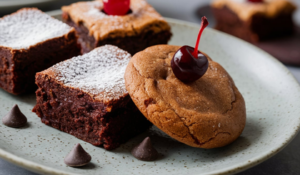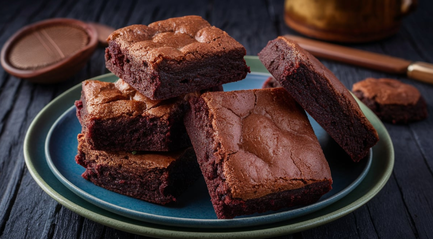Introduction
Brownies and brownie cookies are beloved treats that, while sharing similar origins, have distinct characteristics and appeal to different tastes and occasions. This article will delve into the differences between brownies and brownie cookies, exploring their ingredients, textures, flavors, and the best scenarios for enjoying each. By understanding these differences, you’ll be better equipped to decide which treat best suits your cravings and occasions.
The Ingredients: A Common Ground with Key Differences
While brownies and brownie cookies share many ingredients, the proportions and additional elements set them apart. Both desserts typically include flour, sugar, eggs, butter, and cocoa or chocolate. However, the texture and flavor are influenced by the ratios and the inclusion of specific ingredients.
Brownies
Brownies are dense, fudgy, and rich. They usually have a higher ratio of butter and chocolate, resulting in their signature moist and chewy texture. The batter is thicker, and the baking process helps create a slightly crispy top with a soft, gooey center. Brownies may also include add-ins like nuts, chocolate chips, or a swirl of caramel or cream cheese.
Brownie Cookies
Brownie cookies, on the other hand, aim to capture the essence of a brownie in a portable, bite-sized form. The batter for brownie cookies is generally less dense, producing a cookie with a slightly crisp edge and a soft, chewy interior. They often include similar add-ins, like chocolate chips or nuts, but the dough is typically chilled before baking to help maintain the cookie shape.
Textures and Consistency: The Chew Factor
One of the most significant differences between brownies and brownie cookies lies in their texture. This aspect greatly influences personal preference and the desired experience of the eater.
Brownie Texture
Brownies are renowned for their dense, moist texture. The combination of high fat content from butter and a lower flour-to-liquid ratio creates a fudgy consistency that many people love. The top crust of a brownie can be slightly crisp, providing a delightful contrast to the gooey center. The chewiness is a defining characteristic, making each bite indulgently rich.
Brownie Cookie Texture
Brownie cookies strive to balance the dense chewiness of brownies with the lighter texture of cookies. They often have a slightly crispy edge due to the high sugar content and the Maillard reaction during baking. The interior remains soft and chewy, similar to a brownie but with a lighter mouthfeel. This dual texture makes brownie cookies an excellent choice for those who enjoy a variety of textures in a single bite.
Flavor Profiles: Intensely Chocolatey in Different Forms
The flavor profile of brownies and brownie cookies is fundamentally similar, given their shared ingredients. However, the experience of that flavor can differ due to texture and form.
Brownie Flavor
Brownies offer an intense chocolate experience. The higher fat content and density allow for a more concentrated chocolate flavor. The use of high-quality cocoa powder or melted chocolate significantly impacts the depth and richness of the taste. Additions like espresso powder or vanilla extract can enhance the chocolate notes, making brownies a decadent treat for chocolate lovers.
Brownie Cookie Flavor
Brownie cookies provide a chocolatey flavor that is slightly less intense but still satisfying. The lighter texture can make the chocolate taste seem more subtle, but still pronounced. These cookies are often enhanced with chocolate chips or chunks, which add bursts of chocolate flavor throughout. The slightly crispy edges can introduce a caramelized note, adding complexity to the overall flavor.

Versatility and Occasions: When to Choose Each
Choosing between brownies and brownie cookies often comes down to the occasion and the desired experience. Both treats have their unique advantages, making them suitable for different scenarios.
When to Choose Brownies
Brownies are perfect for occasions where a rich, indulgent dessert is desired. They are ideal for sharing at parties, potlucks, or family gatherings. Brownies can be served warm with a scoop of ice cream for an extra decadent dessert. Their dense texture makes them a satisfying treat on their own or paired with a cup of coffee or milk.
When to Choose Brownie Cookies
Brownie cookies are an excellent choice for more casual settings where portability is a priority. They are easy to pack for picnics, lunchboxes, or road trips. Their smaller, individual size makes them convenient for portion control and sharing without the need for utensils. Brownie cookies also make great gifts, as they can be neatly packaged and stay fresh longer than brownies.
The Baking Process: Techniques and Tips
The process of making brownies and brownie cookies involves some key differences, particularly in the mixing and baking stages. Understanding these techniques can help ensure the best results for each treat.
Baking Brownies
To make brownies, start by melting butter and chocolate together, then allow the mixture to cool slightly before adding the sugar and eggs. The eggs should be added one at a time, beating well after each addition to incorporate air and create a glossy batter. Gently fold in the dry ingredients, being careful not to overmix, which can lead to tough brownies. Bake in a preheated oven until a toothpick inserted in the center comes out with a few moist crumbs. Let the brownies cool completely before cutting to allow them to set.
Baking Brownie Cookies
For brownie cookies, begin by melting the butter and chocolate, similar to the brownie-making process. However, the batter for brownie cookies should be thicker to hold its shape during baking. After mixing the wet ingredients, chill the dough for at least 30 minutes to an hour. This step helps the cookies maintain their shape and prevents excessive spreading. Scoop the chilled dough onto a baking sheet and bake until the edges are set but the centers are still soft. Allow the cookies to cool on the baking sheet for a few minutes before transferring to a wire rack to cool completely.
Pairings and Serving Suggestions
The way you serve and pair brownies and brownie cookies can enhance their flavors and elevate the overall experience. Here are some ideas for each treat:
Pairings for Brownies
- Ice Cream: A classic pairing, vanilla or coffee ice cream complements the rich chocolate flavor.
- Fresh Berries: Strawberries, raspberries, or a mixed berry compote add a refreshing contrast.
- Whipped Cream: Lightly sweetened whipped cream can balance the density of brownies.
- Espresso: The bitterness of espresso cuts through the sweetness, enhancing the chocolate notes.
Pairings for Brownie Cookies
- Milk: A glass of cold milk is a timeless match for the soft, chewy texture of brownie cookies.
- Fruit: Slices of pear or apple provide a crisp, juicy contrast.
- Nut Butter: A spread of almond or peanut butter adds richness and complements the chocolate.
- Coffee: A cup of coffee or a latte enhances the chocolate flavor and provides a satisfying drink alongside the cookies.
Health and Nutritional Insights
While both brownies and brownie cookies are indulgent treats, there are ways to make them slightly healthier without sacrificing flavor.
Healthier Brownies
- Use Whole Wheat Flour: Substitute part or all of the all-purpose flour with whole wheat flour for added fiber.
- Reduce Sugar: Cutting back on sugar or using natural sweeteners like honey or maple syrup can make brownies less sugary.
- Add Vegetables: Pureed vegetables like zucchini or sweet potato can add moisture and nutrients without affecting the flavor.
- Use Dark Chocolate: Opting for dark chocolate with a high cocoa content can increase antioxidants and reduce sugar.
Healthier Brownie Cookies
- Oat Flour: Replace some flour with oat flour for added fiber and a slightly nutty flavor.
- Greek Yogurt: Substitute part of the butter with Greek yogurt to reduce fat and add protein.
- Coconut Sugar: Use coconut sugar as a lower glycemic index alternative to regular sugar.
- Chia Seeds: Add a tablespoon of chia seeds for an extra boost of omega-3 fatty acids and fiber.
User Testimonials and Reviews
Feedback from those who have tried both brownies and brownie cookies can provide valuable insights into their preferences and experiences.
Brownie Testimonials
- Sarah M.: “I love making brownies for family gatherings. They’re always a hit, especially when served warm with a scoop of vanilla ice cream. The fudgy texture is just irresistible!”
- James L.: “Brownies are my go-to dessert. I like experimenting with different add-ins like walnuts and caramel. They never disappoint and are always so rich and chocolatey.”
Brownie Cookie Testimonials
- Emma R.: “Brownie cookies are perfect for my kids’ lunchboxes. They’re easy to pack, and the kids love them. Plus, they stay fresh for days!”
- Mark T.: “I prefer brownie cookies for road trips. They’re less messy than regular brownies and just as delicious. The combination of crispy edges and chewy centers is perfect.”
Conclusion: Which Is Right for You?
Both brownies and brownie cookies have their unique charm and appeal. Whether you prefer the dense, fudgy texture of brownies or the portable, chewy delight of brownie cookies, each treat offers a delightful way to enjoy chocolate. By understanding the differences in ingredients, texture, flavor, and occasion suitability, you can make an informed choice based on your preferences and needs.
Brownies are ideal for rich, indulgent experiences, perfect for sharing at gatherings or savoring with a cup of coffee. Brownie cookies, with their convenient size and versatile nature, are great for on-the-go snacks, casual settings, or as thoughtful gifts. Ultimately, the choice between brownies and brownie cookies comes down to personal preference and the occasion at hand. Whichever you choose, you’re sure to enjoy a delicious, chocolatey treat.

